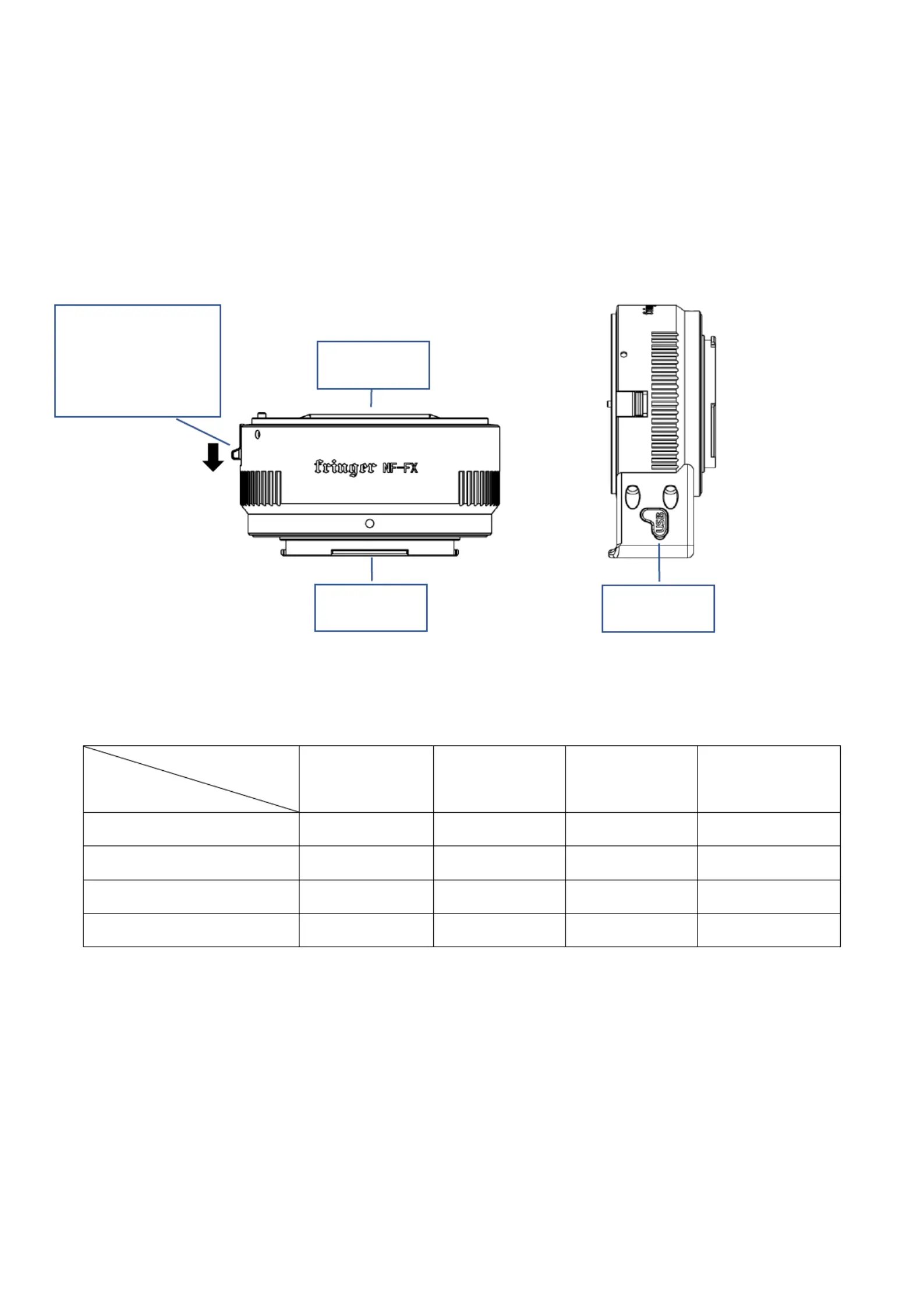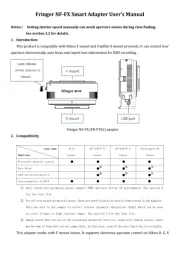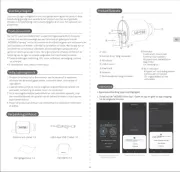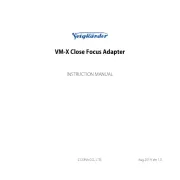Fringer NF-FX Smart Adapter Handleiding
Fringer
Lensadapter
NF-FX Smart Adapter
Bekijk gratis de handleiding van Fringer NF-FX Smart Adapter (7 pagina’s), behorend tot de categorie Lensadapter. Deze gids werd als nuttig beoordeeld door 297 mensen en kreeg gemiddeld 4.9 sterren uit 149 reviews. Heb je een vraag over Fringer NF-FX Smart Adapter of wil je andere gebruikers van dit product iets vragen? Stel een vraag
Pagina 1/7

1
Fringer NF Smart Adapter User’s Manual-FX
Notice Setting shutter speed manually can avoid aperture noises during view finding. :
See section 3.2 for details.
1. Introduction
This product is compatible with Nikon F mount and Fujifilm X mount protocols. It can control lens’
aperture electronically, auto focus and report lens information for EXIF recording.
Fringer FX (FR FTX1) adapterNF- -
2. Compatibility
Lens
Lens
Lens
Lens Lens type
type
type
type type
funct
funct
funct
functfunctions
ions
ions
ionsions
AF D
Lenses
AF AF-S/ -P G
Lenses
AF-S/AF-P E
Lenses
Third party AF
lenses
Electronic aperture control
●
●
●
●
Auto focus
●
①
①
①
①①
●
①
①
①
①①
●
①
①
①
①①
LaCA correction profile
●
②
②
②
②②
●
②
②
②
②②
●
②
②
②
②②
Lens parameters in EXIF
●
●
●
●
① Only tested and optimized lenses support PDAF and have better AF performance. See sect ion 5
for the lens list.
② For all tested and optimized lenses, there are profile data for each of them stored in the adapter.
They are sent to the camera to correct lateral chromatic aberration (LaCA) which can be seen
as color fringes on high contrast edges. See sect 5 for the lens list. ion
③ Among lenses that are not on the tested and optimized lens list, especially Tamron lenses, there
may be some of them that are not compatible. In that case, none of the auto functions is available.
This adapter works with F mount lenses. It supports electronic aperture control on Nikon D, G, E
Lens release
(Arrow: direction to
release )
F mount
X mount
USB port

2
lens and other electronic lenses from third parties like Sigma and Tamron. There is an aperture es F
motor inside the adapter. Thus, lenses with mechanical diaphragm controls as well as electromagnetic
ones are both supported. Meanwhile, it supports auto focus on Nikon AF S, AF P lens and other - - es F
mount lenses from major third parties. Be noted, Nikon AF D lenses can be used. But AF won’t AF -
work as there isn’t AF motor inside these lenses. MF can be used instead. For all F mount lenses that
have CPU chip and successfully communicate with the adapter through lens contacts, EXIF will record
lens parameters like focal length range, max aperture range, current focal length, current aperture, etc.
For lenses with built in image stabilization functions (VR/OS/VC, etc.), image stabilization can be -
activated and controlled the camera menu item “IS MODE”. For lenses without built in image by -
stabilization functions, IBIS can be activated.
This adapter works on X mount cameras. However, due to capability differences of different
camera models, its performance may vary.
CMOS
CMOS
CMOS
CMOSCMOS Type
Type
Type
Type Type
Camer
Camer
Camer
CamerCamera model
a model
a model
a model a model
Compa
Compa
Compa
CompaCompatibility de
tibility de
tibility de
tibility detibility description
scription
scription
scription scription
X-Trans I &
non X-Trans
X- , X-Pro1, X-M1, X-A1, X-A3, E1
X-A5, X-A7, X-T100, X- T200
No PDAF support. Poor AF performance. Use MF if
necessary.
X-Trans II
X-E2, X-E2s, X-T1, X- T10
PDAF focus area is very small. AF performance is not so
good.
X-Trans III
X-H1, X-T2, X-T20, X-Pro2, X- E3
7 columns of AF points in the middle support PDAF.
Better AF performance if PDAF activated.
X-Trans IV
X-T3, X-T30, X-Pro3, X-T4, X-S10
All AF points support PDAF. A big leap in AF
performance. Recommended!
We have tested and optimized over 90 models of F mount lenses. All optimized lenses can activate
all the PDAF focus points and gain better AF performance. However, the F mount is a huge system a
and there are so many different lens models. A lot of them have not been tested and optimized, yet.
Most of them would work on the adapter. However, the AF performance may be er as PDAF may low
not work at all. And small amount of them, such as some of Tamron lenses, may not be compatible. If a
you encounter poor AF performance or compatibility issues, please wait for us to test and optimize
that lens and support it in future firmware updates.
S section 5 for tested and optimized lens models.ee
3. Function descriptions
3.1 Lens installation and self test-
When you install a F mount lens, make sure the lens is turned to the proper position and get
locked. Meanwhile, the lens release button should be up normally. Or it may cause camera malfunction

3
such as flashing screen.
When you install a lens that is not on the tested and optimized lens list and power on the camera
for the first time, the adapter may drive lens’ AF module to the close end and then to infinity to do a
self test and calibration. During this procedure, please do not touch the MF ring of the lens. Or you -
may interfere with the calibration. If there is something wrong with the self test procedure the AF -,
function may not be in a normal state. If that happens turning on and then turning off the camera at ,
once will clear the defective calibration data. Install another lens and power on the camera will do ing
the same. There isn’t such procedure for any tested and optimized lenses.
3.2 Setting aperture and shutter speed value
Like Fujifilm XC lenses, there is no aperture ring on the adapter. You may use camera’s command
dial to set aperture value. Please refer to the camera’s manual for more details.
For Nikon AF D lenses, please set aperture ring on the lens to the minimum position (maximum -F
number). Or the lever inside the lens may interfere with that of the adapter when controlling
diaphragm.
You may set shutter speed through the command dials on camera. During view finding, when
environment brightness changes, the lens aperture blades may move frequently with a minor noise
and brightness change of LCD or EVF. It only occurs when both AF and aperture priority are enabled.
That’s a unique behavior of the Fujifilm mirrorless. Native XF lenses behave the same. But their
aperture motor moves so fast and silent that you will never notice. However, SLR lenses’ aperture ly
moves slower and noisier. If you want to avoid it, manually set the shutter speed. Of course, you may
still set shutter speed to auto if that’s tolerable. Be noted that if “PREVIEW EXP./WB IN MANUAL
MODE” in the camera menu is set to “OFF”, the described issue may occur even the shutter
speed is set manually.
Regarding D/G lenses from Nikon and other non electromagnetic auto lenses from third parties, -
there is a mechanical coupling between the lens and the adapter which may bring aperture control
tolerance inevitably. When the camera is metering, if the shutter speed is set to auto, e.g., aperture
priority mode, it may use a different aperture from your setting. That may cause metering tolerance.
To avoid it, you need to set the shutter speed manually so that the camera will use the same aperture
setting when metering.
3.3 Setting AF modes
For a better AF performance, please always use phase detection focus points. See the dashed box
in the following charts (X Trans II and III only). For cameras equipped with X Trans III CMOS, e.g. X H1, - - -
X Pro2, X T2, X T20 - - - and X-E3, use central 7 x 7 among all 91 AF points. For cameras equipped with
Product specificaties
| Merk: | Fringer |
| Categorie: | Lensadapter |
| Model: | NF-FX Smart Adapter |
Heb je hulp nodig?
Als je hulp nodig hebt met Fringer NF-FX Smart Adapter stel dan hieronder een vraag en andere gebruikers zullen je antwoorden
Handleiding Lensadapter Fringer

23 Juli 2025
Handleiding Lensadapter
- Sony
- Panasonic
- Canon
- Fujifilm
- Hasselblad
- Kenko
- Neewer
- Praktica
- Sigma
- Voigtlaender
- Voigtlander
- Vello
- Fotodiox
- Viltrox
Nieuwste handleidingen voor Lensadapter

29 Maart 2025

24 Februari 2025

3 Februari 2025

1 December 2024

15 November 2024

14 Augustus 2024

28 Mei 2024

26 April 2024

2 Februari 2024
